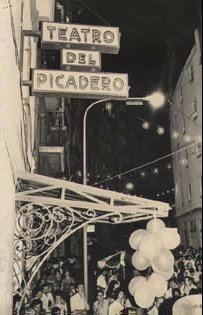Theatre of Argentina facts for kids
Buenos Aires is a very important city for theatre around the world. The Teatro Colón is a famous place for opera and classical music shows. It was built a long time ago, in the late 1800s. Many people say its sound is the best in the world! The theatre was recently fixed up to keep its amazing sound and beautiful French-romantic style. It also has a special Golden Room for smaller music shows and a museum.
Corrientes Avenue is a street full of theatres in Buenos Aires. It is known as the street that never sleeps. Some people even call it the Broadway of Buenos Aires! Many actors, musicians, and filmmakers started their careers in its theatres. The Teatro General San Martín and the Teatro Nacional Cervantes are two of the most famous theatres there. Other important theatres in Argentina include the Teatro Argentino de La Plata, El Círculo in Rosario, Independencia in Mendoza, and Libertador in Córdoba.
Many talented people have written plays in Argentina. Some famous playwrights are Griselda Gambaro, Roberto Cossa, and Carlos Gorostiza. Argentina has also produced great ballet dancers like Julio Bocca and Norma Fontenla.
Contents
History of Argentine Theatre
Early Days of Theatre
The story of theatre in Argentina began a long time ago, in the 1500s and 1600s. At first, performances were put on by missionaries. They used plays to teach local Indigenous people about Christianity. These shows were not very regular until 1747. In 1757, the first outdoor theatre was built, but it only lasted a few years.
The First Theatre: La Ranchería
In 1783, the first leader of the colony, Juan José de Vértiz y Salcedo, helped create the colony's first theatre. It was called La Ranchería. An actor named Francisco Velarde suggested the idea and became the theatre's manager. The church was not happy about the theatre. So, Vértiz agreed that the church had to approve every play before it was shown.
In 1786, a play called Siripo was performed there. This play is now mostly lost, but it is considered the first Argentine play. It was written by a poet from Buenos Aires, Manuel José de Lavardén. The story was about a real event from the early days of Argentina. The La Ranchería theatre was used until it burned down in 1792.
New Theatres and Music
The second theatre in Buenos Aires was Teatro Coliseo. It opened in 1804. This theatre was used for a very long time, more than any other in the country.
Blas Parera, who wrote the music for the Argentine National Anthem, became famous for writing music for theatre in the early 1800s. Theatre faced some tough times later, but it grew stronger as the country's economy improved. The government helped theatre grow by building the Colón Theatre in 1857. This theatre showed classical music, operas, and plays. In 1871, Antonio Petalardo opened the successful Teatro Opera. This inspired other people to invest in theatre in Argentina.
Gauchos and Spanish Influence
In 1874, a man named Juan Moreira was killed. He was a traveling singer who was being hunted. His sad story inspired a play by Eduardo Gutiérrez in 1884. This play made the "gaucho" (a type of cowboy) a hero on the Argentine stage. Gauchos often appeared in plays after that.
Later, Spanish theatre became very popular in Argentina. In 1897, a Spanish theatre producer named María Guerrero moved to Argentina with her acting group. She made professional theatre very popular. She made the Teatro Odeón a central place for theatre. Her work led to the creation of the national theatre, the Cervantes Theatre, in 1921.
In the late 1800s, a Spanish type of musical play called zarzuela was very popular. Buenos Aires even became the main city for zarzuela in Latin America. This led to a new Argentine style called zarzuela criolla.
New Styles and Movements
Many people from Europe moved to Argentina. This led to new types of theatre that showed their experiences. One style was called sainete criollo. It focused on the lives of European immigrants and how they fit into Argentine culture.
Florencio Sánchez was a very important person in professional theatre in Argentina and Uruguay. During the 1920s and 1930s, playwrights like Roberto Arlt and Gregorio de Laferrère found inspiration in local life. This also helped amateur theatre groups grow.
A movement called Teatro Independiente (Independent Theatre) started. It wanted to bring back more unusual and sometimes strange topics into plays. This movement lasted from 1950 to 1955. It inspired a new group of young playwrights like Copi and Carlos Gorostiza.
After 1950, Gorostiza and others made Realism popular in Argentine theatre. This style showed life as it really was. Later, Griselda Gambaro and Eduardo Pavlovsky made theatre of the absurd popular after 1960. This style often showed strange or confusing situations.
Theatre in Difficult Times
In the late 1970s, Argentina went through a difficult time with a military government. Many actors and writers left the country. But around 1980, things started to get a little easier for artists.
A playwright named Osvaldo Dragún gathered other artists. They fixed up an old factory to create the Teatro Abierto (Open Theatre) movement. From 1981 to 1985, this movement bravely put on plays to challenge the government's censorship.
Theatre continued to do well before and after Argentina became a democracy again in 1983. Many established and new playwrights kept creating amazing works. Today, more than 80 theatre shows are performed every weekend in Buenos Aires alone! The stage also hosts popular comedy acts like Enrique Pinti and the musical comedy group, Les Luthiers.
See also
 In Spanish: Teatro en Argentina para niños
In Spanish: Teatro en Argentina para niños


